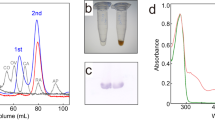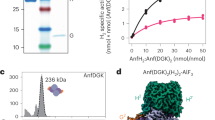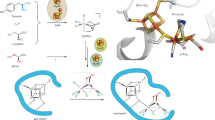Abstract
A FERREDOXIN-LIKE protein from Azotobacter vinelandii having 6–7 Fe and 6–7 S2− per mol and a molecular weight of 14,000 has been described by Shethna1 and Yoch et al.2. Its biochemical properties3, electron paramagnetic resonance and redox behaviour4,5, and primary sequence6 have also been studied. This work has established that there are two Fe–S centres separated by 0.744 V in reduction potential, one behaving like the [Fe4S4S4Cys] cluster in high-potential iron proteins, the other displaying novel characteristics. The distribution of cysteines in the N-terminal sequence is distinctly non-homologous with clostridial ferredoxins. Extrusion of the Fe–S cores by thiol displacement produces unique species, suggesting the presence of a new chromophore structure7. I report here crystallographic studies of the protein in a tetragonal crystal form which have led to an electron density map at 4.0 Å resolution. This map reveals two Fe–S clusters of clearly different size and shape. It has not been previously shown that this Fe–S protein, or any other, actually contains clusters of differing structure.
This is a preview of subscription content, access via your institution
Access options
Subscribe to this journal
Receive 51 print issues and online access
$199.00 per year
only $3.90 per issue
Buy this article
- Purchase on Springer Link
- Instant access to full article PDF
Prices may be subject to local taxes which are calculated during checkout
Similar content being viewed by others
References
Shethna, Y. I. Biochim. biophys. Acta 205, 58–62 (1970).
Yoch, D. C., Benemann, J. R., Valentine, R. C. & Arnon, D. I. Proc. natn. Acad. Sci. U.S.A. 64, 1404–1410 (1969).
Yoch, D. C. & Arnon, D. I. J. biol. Chem. 247, 4514–4520 (1972).
Sweeney, W. V., Rabinowitz, J. C. & Yoch, D. C. J. biol. Chem. 250, 7842–7847 (1975).
Yoch, D. C. & Carithers, R. P. J. Bact. 136, 822–824 (1978).
Howard, J. B., Lorsbach, T. & Que, L. Biochem. biophys. Res. Commun. 70, 582–588 (1976).
Averill, B. A., Bale, J. R. & Orme-Johnson, W. H. J. Am. chem. Soc. 100, 3034–3043 (1978).
Stout, C. D. J. biol. Chem. (in the press).
Strahs, G. & Kraut, J. J. molec Biol. 35, 503–512 (1968).
Adman, E. T., Sieker, L. C. & Jensen, L. H. J. biol. Chem. 248, 3987–3996 (1973).
Carter, C. W. et al. J. biol. Chem. 249, 4212–4225 (1974).
Mayerle, J. J., Denmark, S. E., DePamphilis, B. V., Ibers, J. A. & Holm, R. H. J. Am. chem. Soc. 97, 1032–1045 (1975).
Author information
Authors and Affiliations
Rights and permissions
About this article
Cite this article
STOUT, C. Structure of the iron–sulphur clusters in Azotobacter ferredoxin at 4.0 Å resolution. Nature 279, 83–84 (1979). https://doi.org/10.1038/279083a0
Received:
Accepted:
Issue Date:
DOI: https://doi.org/10.1038/279083a0
Comments
By submitting a comment you agree to abide by our Terms and Community Guidelines. If you find something abusive or that does not comply with our terms or guidelines please flag it as inappropriate.



